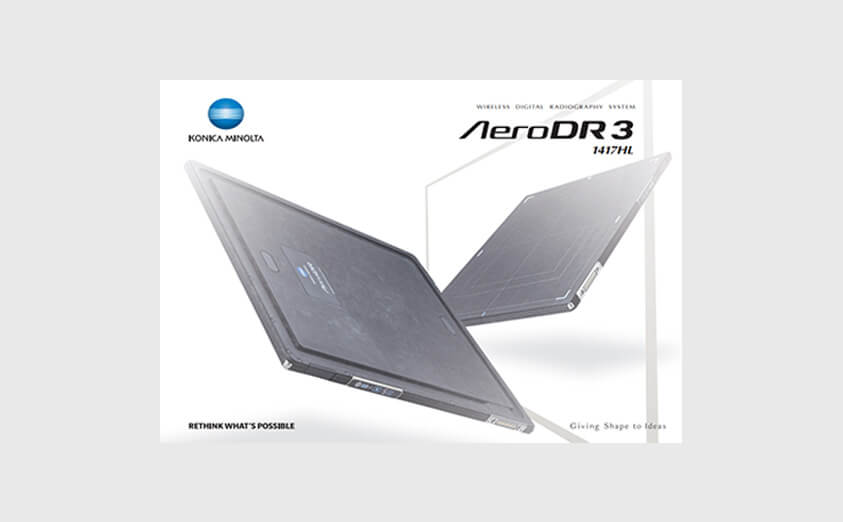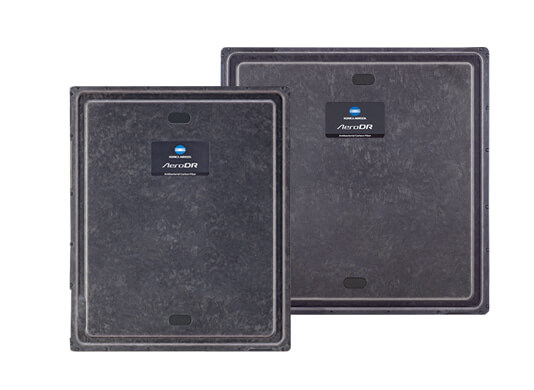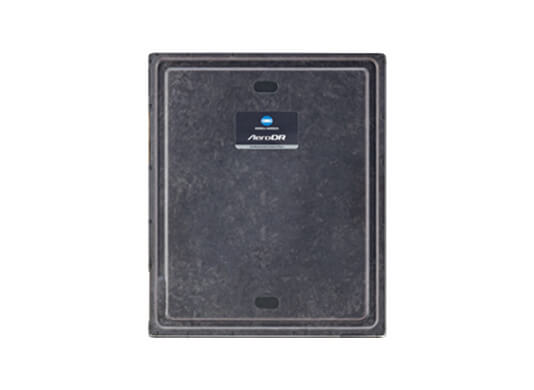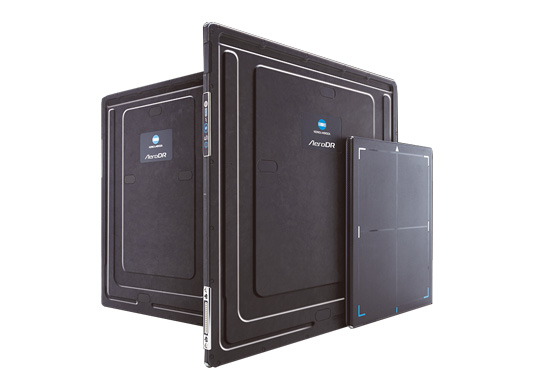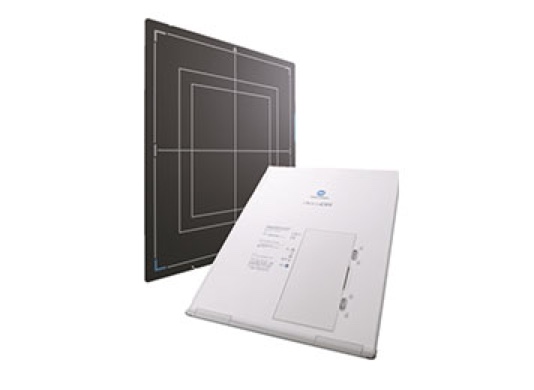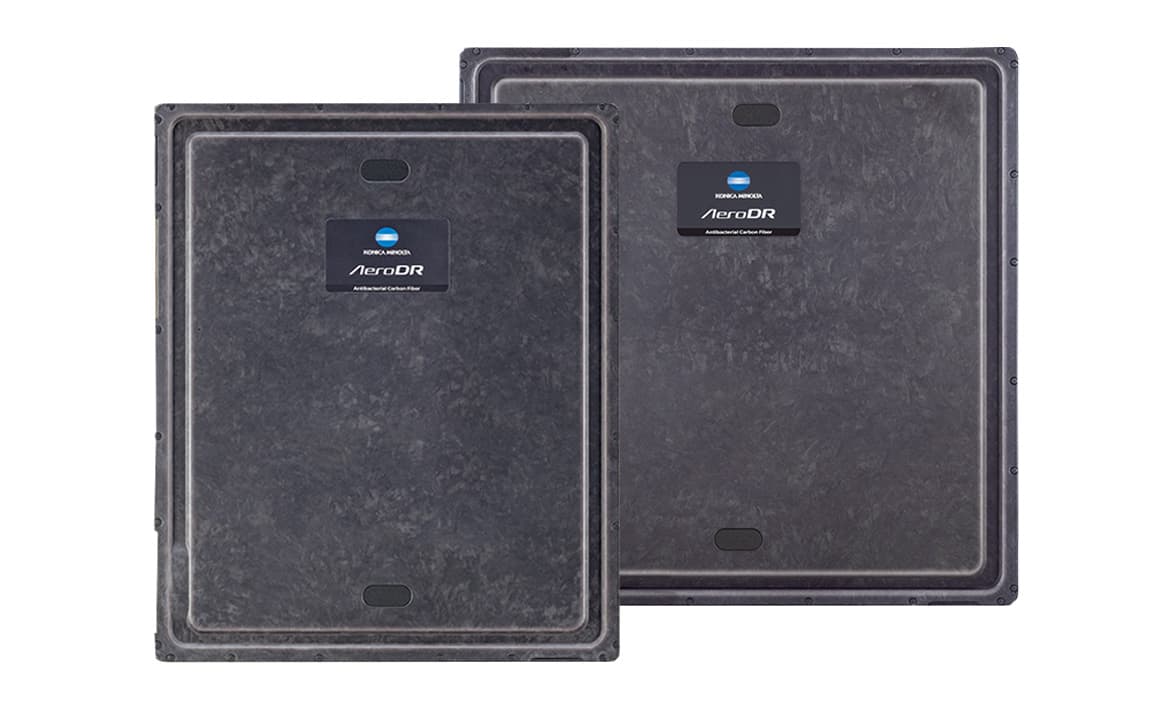
AeroDR 3 HL
AeroDR HL is the top model of the AeroDR family, with a glass-free TFT display. Weighs only 1.9 kg*1 including the battery, which is lighter than a CR cassette. Available in 100μm and 200μm models, depending on the exposure protocol.
*1 Weight of AeroDR 1417HL.
Adoption of glass-free TFT substrate
The previous AeroDR series used a TFT substrate made of glass material, which posed a problem in terms of lighter weight. For the current AeroDR 3, Konica Minolta adopts its first TFT substrate made of thin film, and together with a review of the internal structure, has succeeded in significantly reducing weight.
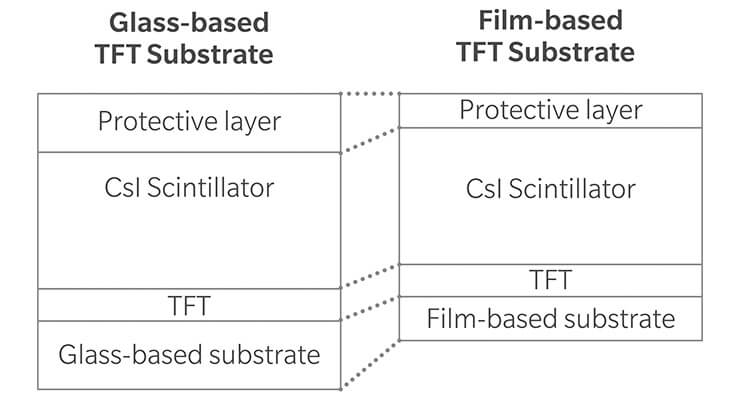
Realization of a lightweight body that surpasses that of CR cassette
By adopting a glass-free TFT substrate and reviewing the internal structure, the AeroDR3 has achieved an ultra-light weight of 1.9kg (4.2lb)*1 including the battery. The lightness far surpasses that of CR cassette, greatly reducing the operator's workload in cassette exposure using mobile X-ray.
*1 Weight of AeroDR 1417HL.
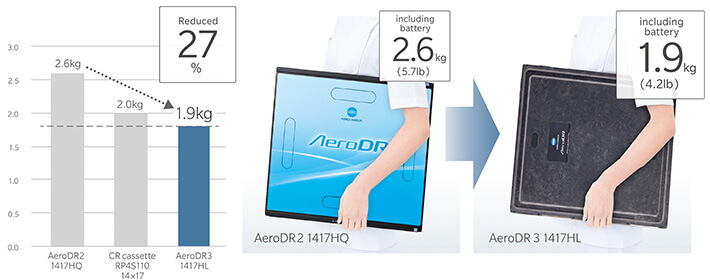
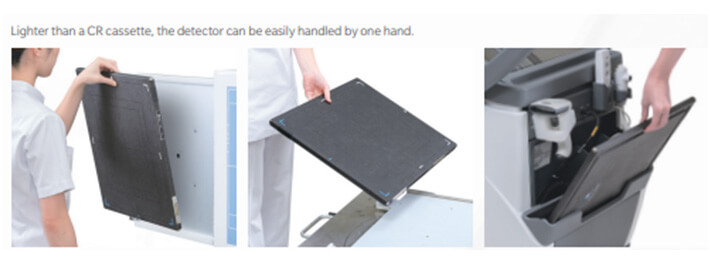
Easy handling that gives a sense of lightweight
Grip design for easier handling
The 4mm depression is provided all around the backside panel surface to make it easier to hold the detector. This excellent design allows your fingers to easily latch onto the panel from any direction, and helps your grasp.
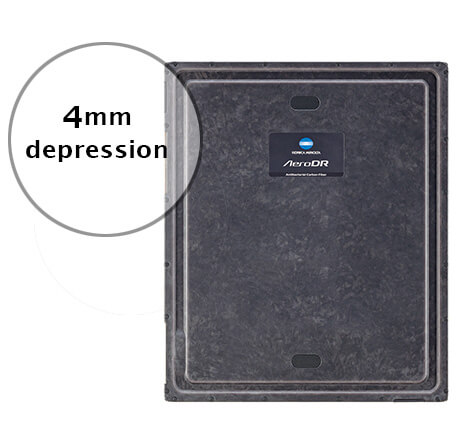
Easy grasping for users in all situations
An easy-to-grasp panel helps support the operator's work in a variety of X-ray examination situations. It can reduce the stress of operators who may experience a feel of fatigue after use or an anxiety of dropping the panel.
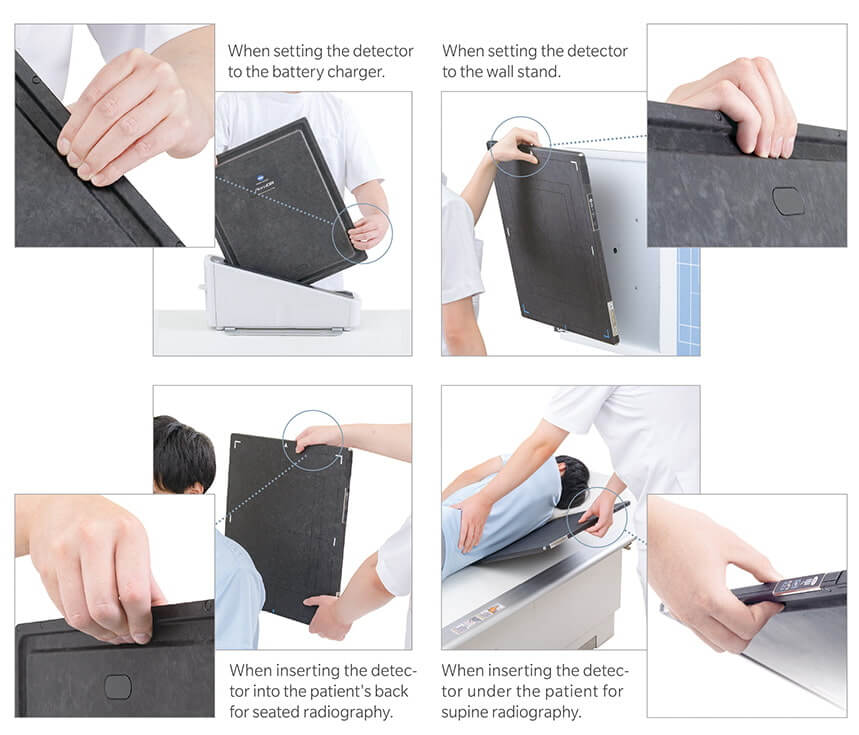
Light and tough. Relentless pursuit of robustness
Evolving carbon body
Each generation of the AeroDR uses a carbon body that has evolved to meet the needs of the times to pursue lightweight, robustness, and easy grasping.
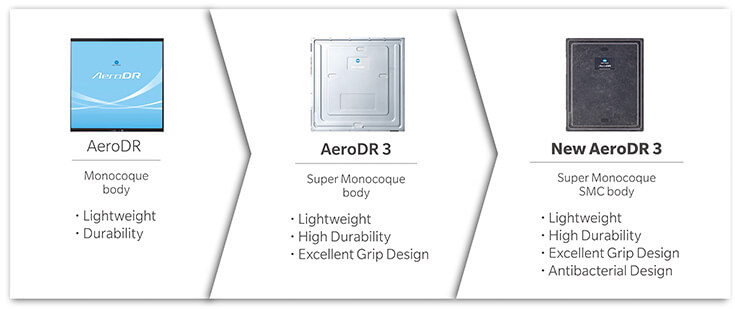
Patient-friendly round shape
The body shape is designed to prevent pain when inserting the detector into the patient's back for portable radiography.
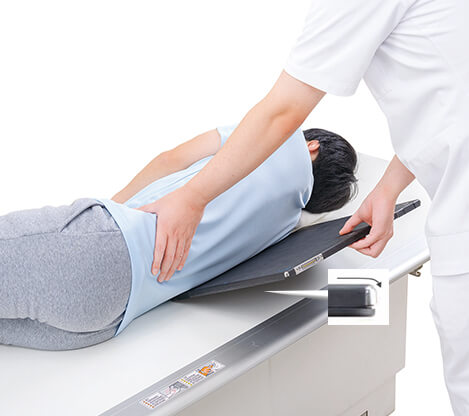
CompSuper monocoque housing structure
Carbon SMC (Carbon Sheet Molding Compound) is used for exterior materials. The housing is complex in shape but seamless in structure, lightweight yet highly rigid, and durable enough to meet the demands of the medical field.

Compliant with IP56 waterproof/dustproof standard
Compliant with the IP56 waterproof/dustproof standard. By adopting a structure where a packing is inserted between the front and back exterior plates, it is easy to maintain the waterproof structure even when subjected to shocks such as drops.
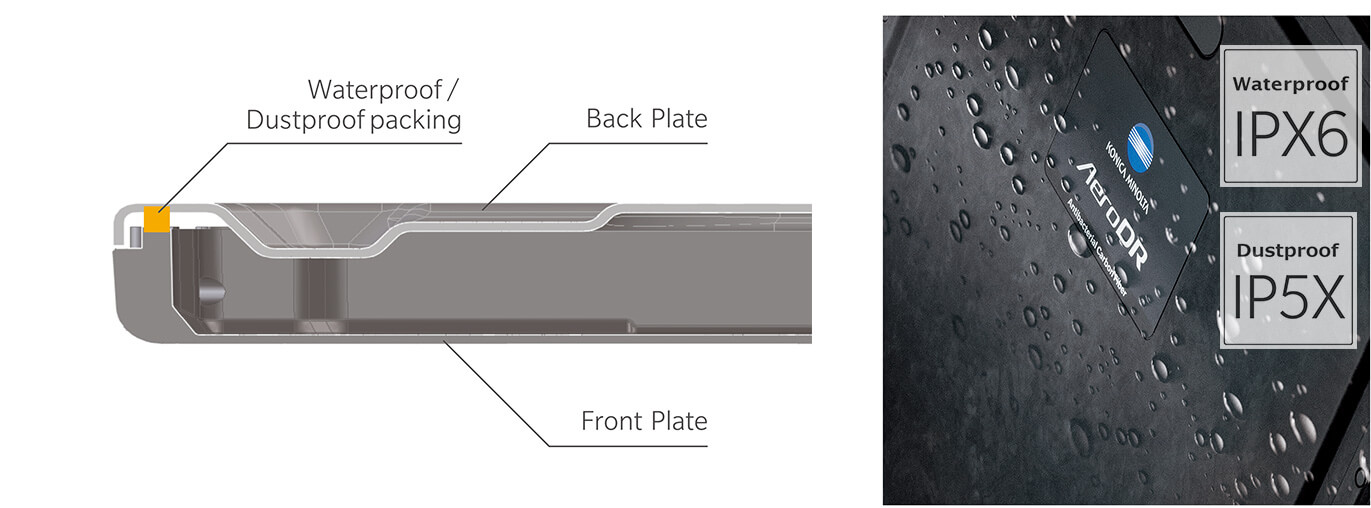
Antibacterial carbon enclosure
An antibacterial material containing Ag (silver) is kneaded into the enclosure material of AeroDR3. The antibacterial agent is evenly dispersed in the material in the thickness direction. Antibacterial property is not lost due to scratches in daily use.
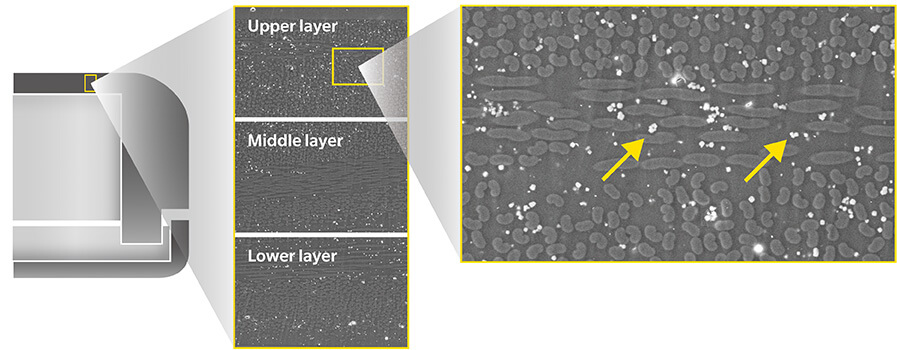
Having cleared MIL-STD-810G drop strength test
The AeroDR 3 also has excellent drop impact resistance. It has cleared the US Department of Defense MIL-STD-810G drop strength test, which measures the shock resistance of the panel when dropped.
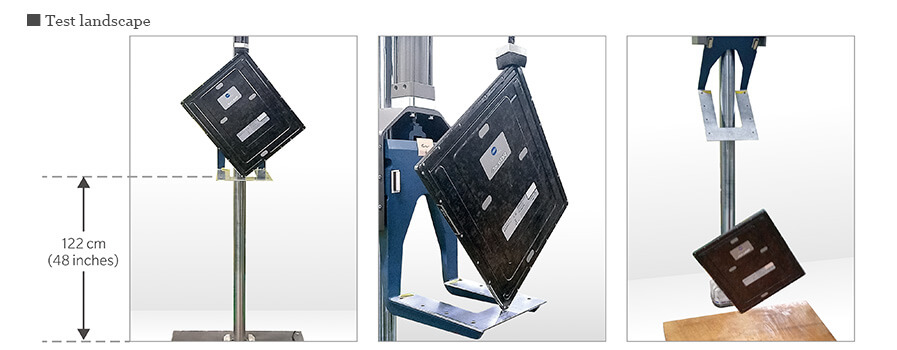
Reliable load bearing performance
The layout in the housing structure has been optimized for every load situation. The detector is equipped with a high load capacity to withstand various examination scenes.
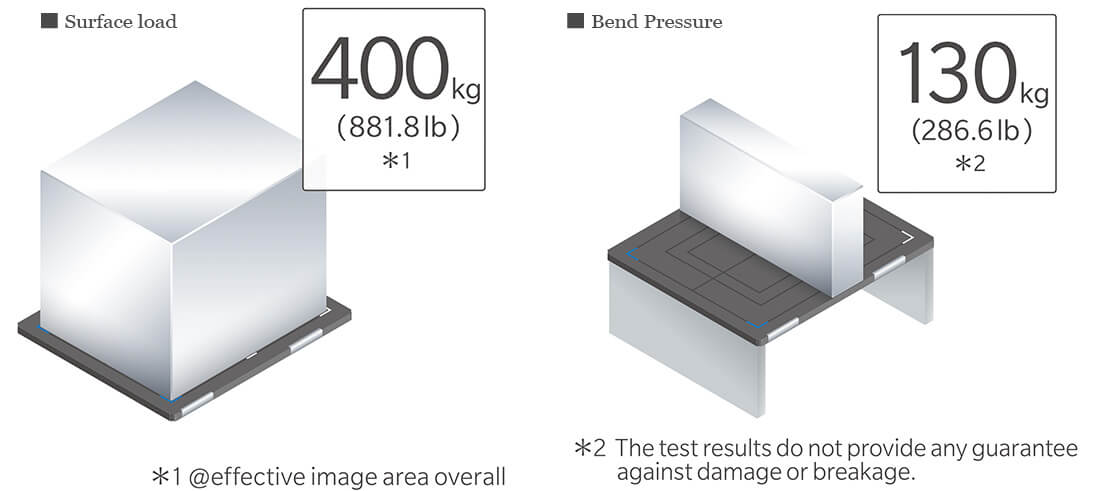
Cleaning with highly concentrated disinfectant solutions is also available
As a disinfectant solution for the AeroDR 3 detector, up to 1% concentration of sodium hypochlorite solution can be used. The body surface shows no deterioration even when soiled by patient's blood or urine and wiped with a high-concentration disinfectant solution.
Available disinfectant
- Ethanol for disinfection
- Isopropanol for disinfection
- Commercial chlorine bleach,
or 1% Hypochlorite
(5-fold dilution of household bleach)
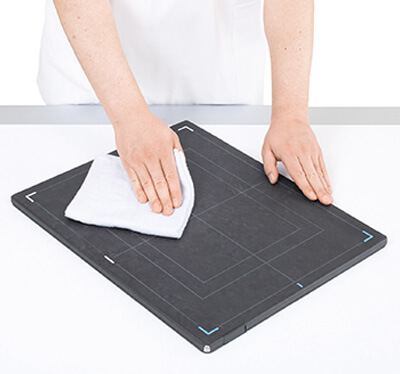
Light weight and high image quality. More premium quality sought in images
High resolution 100/200 μm pixel size
The AeroDR3 offers the world's smallest pixel size of 100 μm. Its binning process allows you to use either 100 μm or 200 μm depending on your radiography protocol.

Achieving DQE 59% (1mR, 1cycle/mm)
The AeroDR3 realizes high resolution and achieves DQE 59% (1mR, 1cycle/mm). In addition to technologies including improved scintillator and electrical noise reduction, the internal structure on the X-ray incident side has become thinner due to the glass-free TFT substrate, thereby reducing the loss of X-ray dose reaching the scintillator. As a result, high DQE is achieved even though the resolution is higher than that of conventional models.
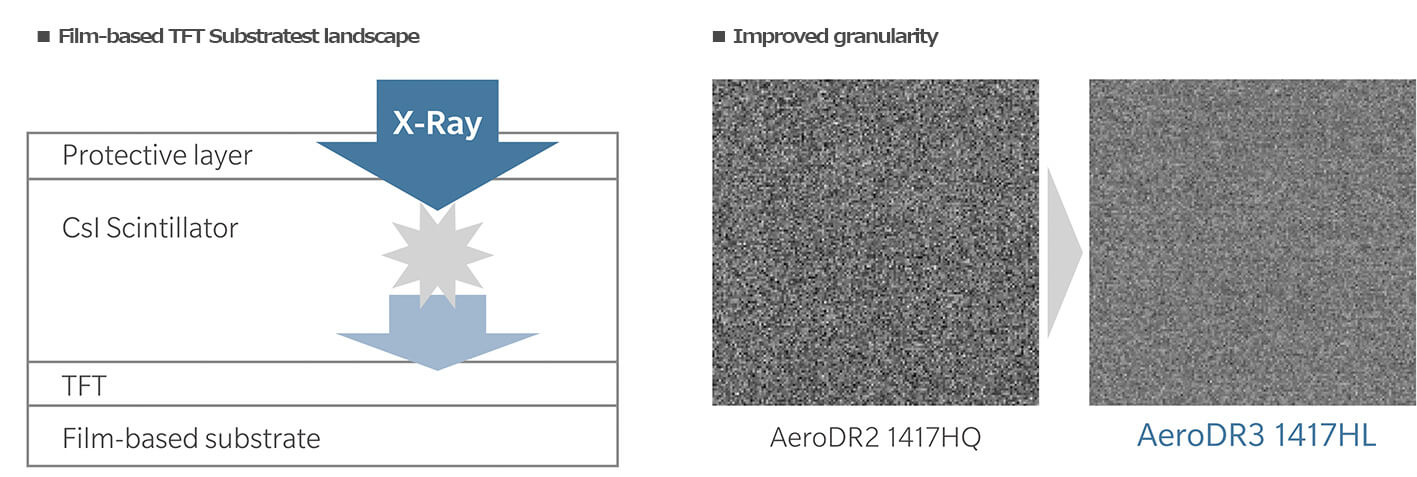
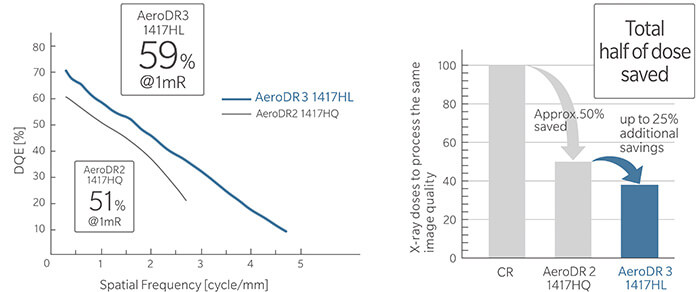
Image Processing Engine "REALISM" for AeroDR3
"REALISM" is an image processing engine developed to maximize the image quality performance of AeroDR3 with high resolution pixels and high DQE. Thanks to its improved frequency enhancement processing, it can more faithfully depict both low and high frequency regions, and realistically produce images of fine structures such as bone trabeculae and of thick body parts (low-dose regions).
Increased sharpness to maximize
With optimized 100μm imaging and improved frequency enhancement processing, high-frequency regions are faithfully depicted. This high-resolution imaging realizes the expression of fine structures.
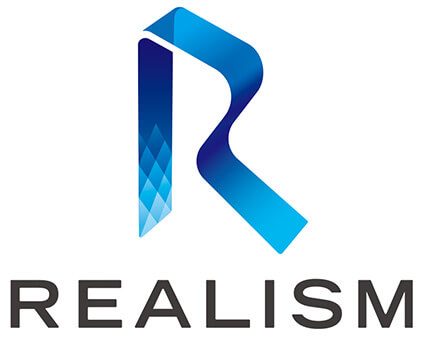

Maintaining contrast while depicting the whole image more clearly
With improved dynamic range compression processing and newly introduced LUT, stereoscopic images are provided by expressing individual structures from low-dose to high-dose regions.
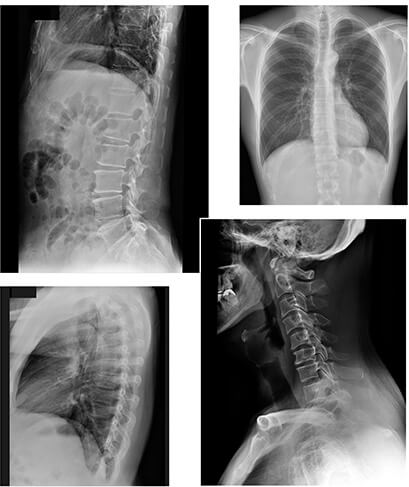
Various functions to support Mobile x-ray
AeroDR Panel Roaming
The roaming function for sharing the AeroDR detector among multiple X-ray rooms has evolved. Roaming can be easily set with a simple button operation on the detector side. The backup of the detector between X-ray rooms and the sharing of the detector with mobile devices enable more efficient panel operation.
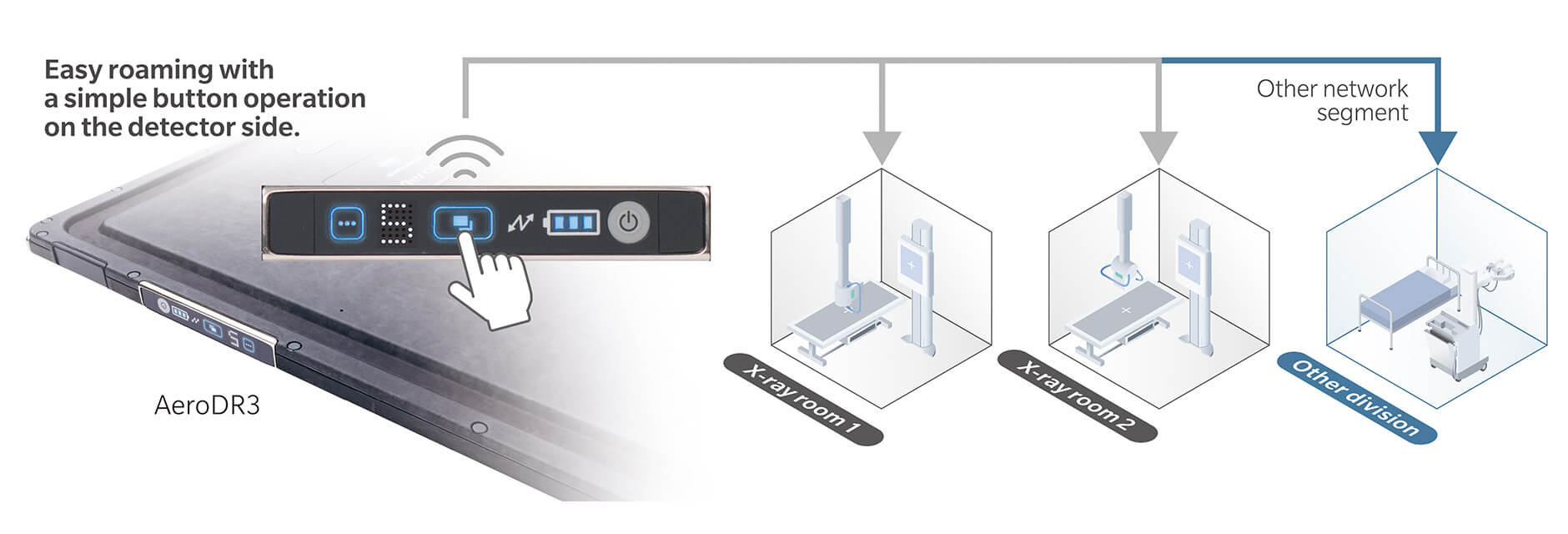
AeroLink
AeroLink enables AP-less connection between the console and AeroDR detector. Any console can be combined with any detector. It is also possible to switch between multiple detectors according to the purpose of radiography.
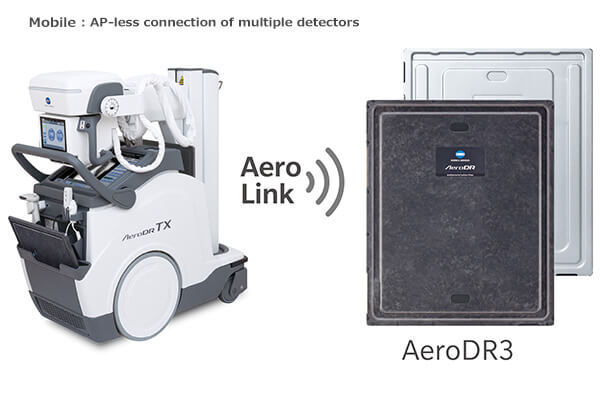
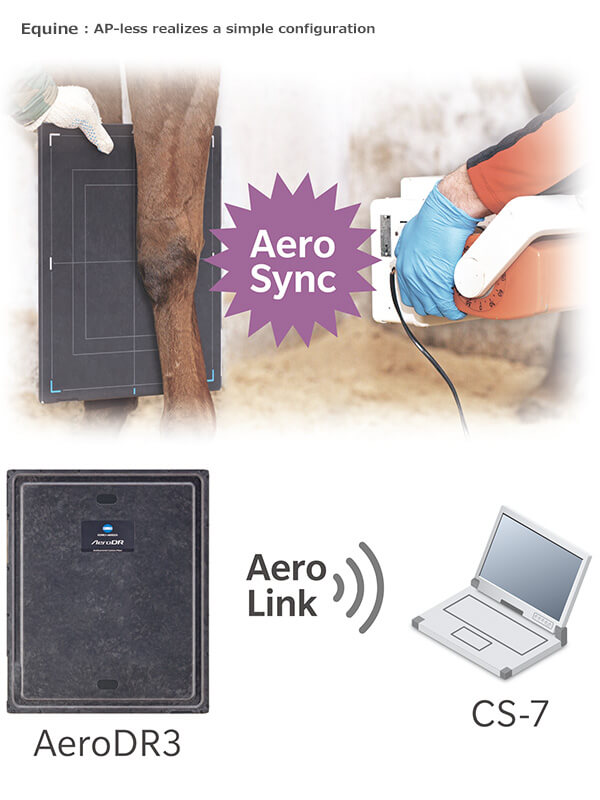
Aero Storage
Equipped with the Aero Storage function that enables mobile X-ray imaging on the detector alone. Up to 100 images can be stored inside the detector and easily exported to the CS-7 console after performing radiography to match them with patient information.
When combined with the optional Mobile Terminal, the detector's status and captured image previews can be checked at hand. This solution is ideal for users who want to speedily take small volumes of images.
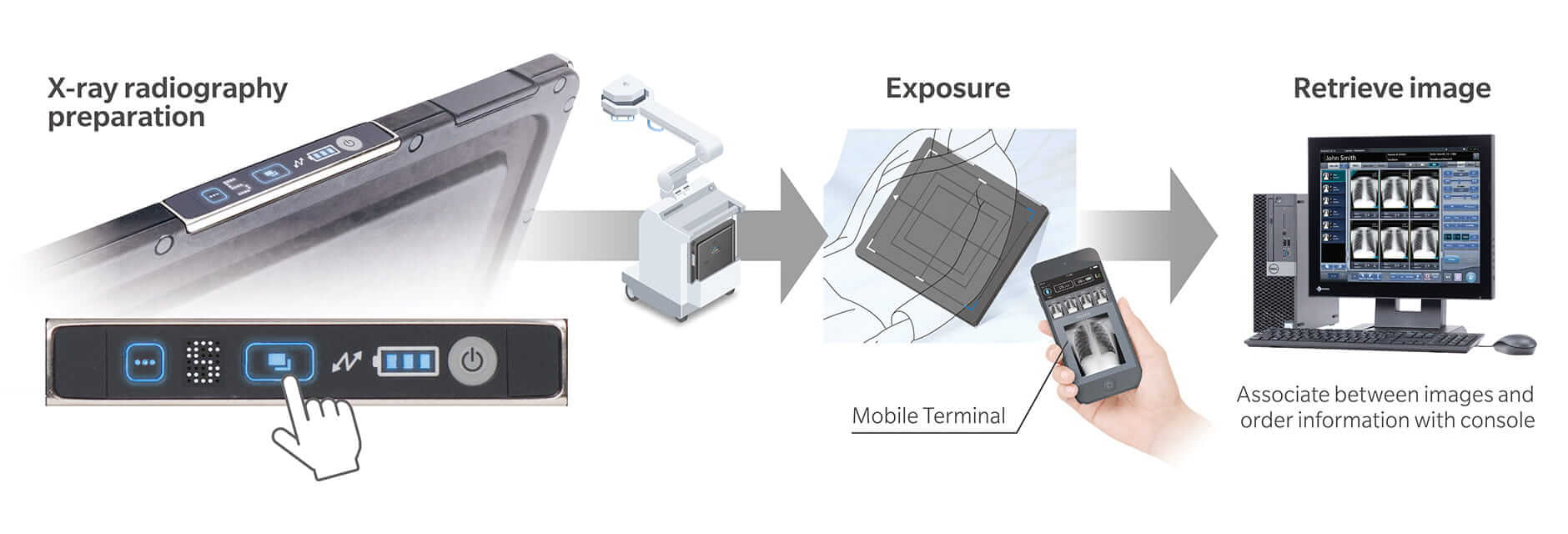
Intelligent Grid
Intelligent Grid is an image processing technology that improves image contrast by removing the effects of scattered radiation through image processing. It allows users to obtain high quality gridless images for mobile radiography.
<Target Areas>
Head (PA/AP, LAT, towne)
Acoustic organ
Neck (PA/AP, LAT, oblique)
C-Spine (PA/AP, LAT, oblique)
Chest (PA/AP, LAT)
T-Spine (PA/AP, LAT)
L-Spine (PA/AP, LAT, oblique)
Abdomen (PA/AP, LAT)
Cystography
Finger bone
Tarsal bone
Phalanges
Toe bone
Ped. Chest (PA/AP, LAT)
Infant (chest and abdomen)
Newborn (chest and abdomen)
*CS-7 Optional license is necessary to use this function
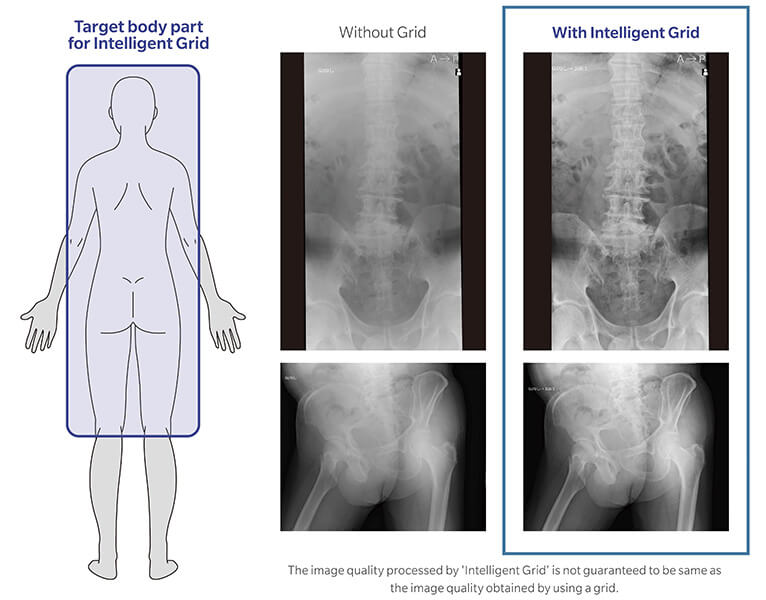
Tube and Gauze Image Enhancement
This image processing is specially designed to make it easier to check the remaining objects in surgical imaging and to confirm the position and route of the catheter tip.
Objects that are difficult to detect with normal image processing can be highlighted.
<Target Areas>
Head (PA/AP)
Neck
Shoulder joint
Chest (PA/AP)
Chest (LAT)
T-Spine
L-Spine
TL-Spine
Abdomen (PA/AP)
Pelvis
Hip joint
Femora
Ped. Chest (PA/AP)
Clavicle (PA/AP)
Knee joint (PA/AP)
Knee joint (LAT)
Knee joint (oblique)
*CS-7 Optional license is necessary to use this function
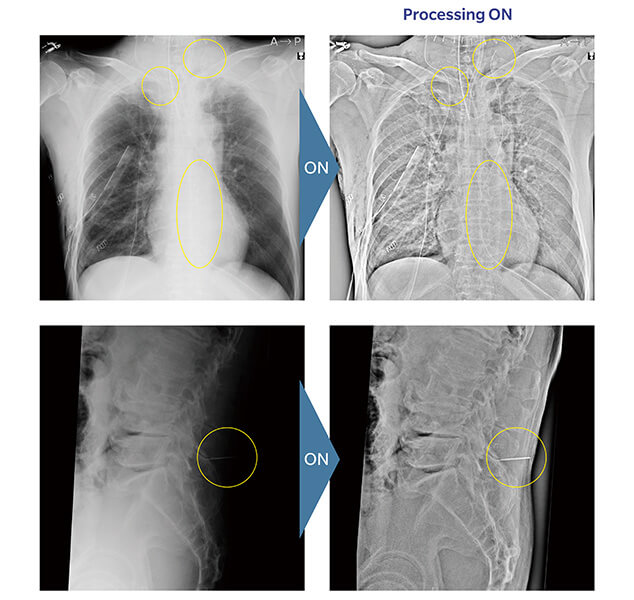
Brochure Download
AeroDR 3 1417HL
Digital Radiography Lineup
*This site is intended for healthcare workers.

